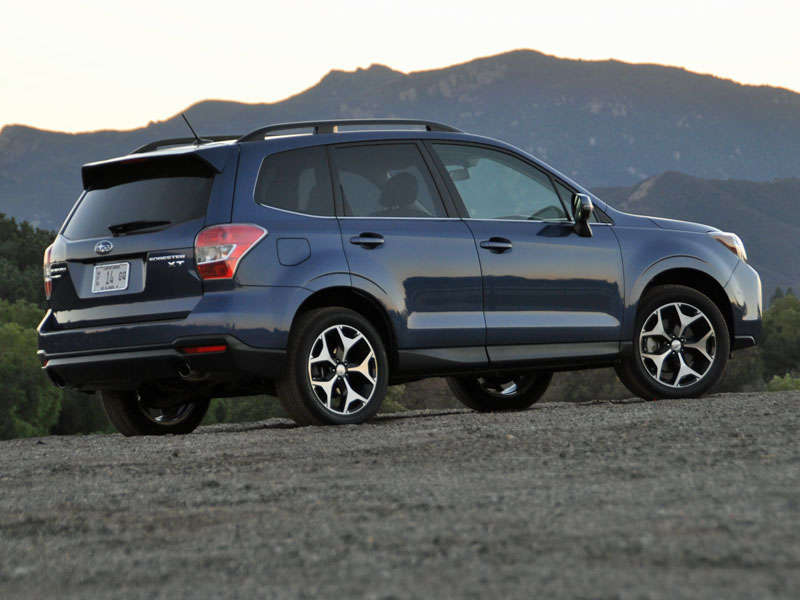Recent Articles
Popular Makes
Body Types
2014 Subaru Forester 2.0XT Review and Quick Spin
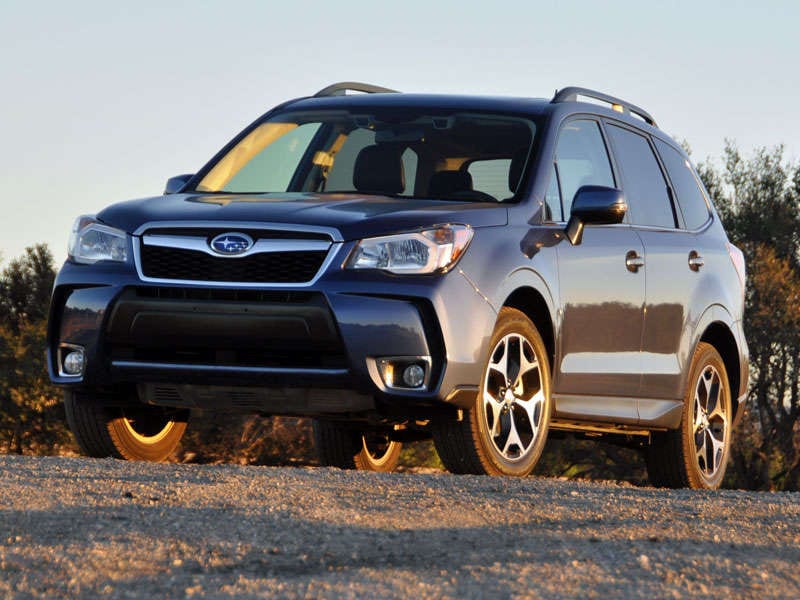
When last I sampled the redesigned 2014 Subaru Forester, the final line in my review was: “Now I just need to get my hands on the turbocharged version.” As it happens, I’ve done just that, and right after Autobytel’s team of editors announced the 2014 Forester as its favorite “Crossover of the Year.”
Now, after a week of subjecting the 2014 Forester 2.0XT to kid-shuttling duties in the suburbs, a trip to the local warehouse store, a drive up the coast to the beach, and some light-duty off-roading, it is clearer than ever why our team, and other critics, applaud the redesigned Forester. However, the complaints I voiced in my original review of the crossover SUV stand pat. Because they are related to things that impact an owner on a daily basis, and they are not necessarily matters of acclimation over time, I urge Subaru to address them as soon as possible.
2014 Subaru Forester 2.0XT Review and Quick Spin: About Our Test Car
The turbocharged version of the 2014 Subaru Forester is called the 2.0XT, and it’s a more satisfying vehicle to drive than the regular-strength 2.5i models, especially if you’re the sort that enjoys the trip to the destination as much as the destination itself.
In addition to a more powerful turbocharged engine, the 2.0XT adds an upgraded version of the standard Forester’s continuously variable transmission, special drivetrain modes including Sport and Sport Sharp (Sport #), dual exhaust outlets, bigger and more capable brakes, and larger 18-inch aluminum wheels with 225/55 Bridgestone Dueler H/L all-season tires. The 2.0XT also gets unique front styling and sport-bolstered front seats, but is otherwise outfitted just like a Forester 2.5i Premium model, including a huge power sunroof. In exchange for these upgrades, Subaru charges $4,500, bringing the Forester 2.0XT Premium’s price tag to $28,820*.
My Marine Blue test vehicle was the 2.0XT Touring, priced at $33,820*. The Touring trim level adds leather seats, a leather-wrapped steering wheel, electroluminescent gauges, automatic dual-zone climate control, a voice-activated navigation system, and a 440-watt premium Harmon Kardon audio system with Aha Radio, satellite radio, Bluetooth audio streaming, USB/iPod connectivity, and an auxiliary audio input jack. You can spot the Forester 2.0XT by its fog lights and side mirrors with integrated turn signal indicators, and this model also includes one-touch folding rear seats, a protective tray for the cargo area, a power tailgate, and an All-Weather Package containing a wiper de-icer system, heated side mirrors, and heated front seats.
The only option installed on my test car was a package containing a keyless passive entry system with push-button starting and Subaru’s EyeSight technology. The EyeSight system includes forward collision warning, pre-collision braking and pre-collision throttle management, lane departure warning, lane sway warning, and an adaptive cruise control system. The only feature it lacks, and the omission is glaring, is a blind-spot information system. Subaru also offers a long list of dealer-installed accessories for the Forester, primarily designed to enhance the crossover SUV for individual lifestyles.
My Forester 2.0XT with EyeSight did not include any of those extras, and wore a bottom line price of $36,220*. For comparison, that’s almost as much as the well-equipped Jeep Cherokee Trailhawk that I recently reviewed.
* Prices include a destination charge of $820
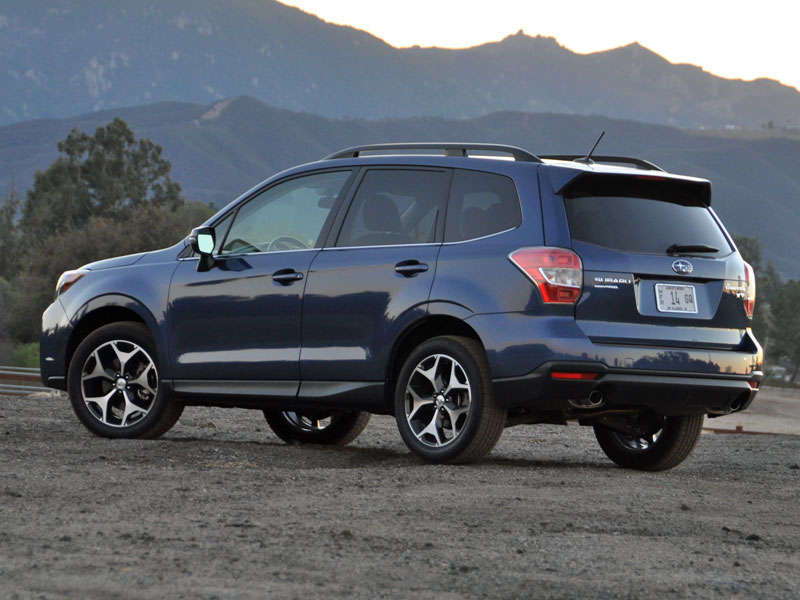
2014 Subaru Forester 2.0XT Review and Quick Spin: Styling and Design
Rarely have Subarus been aesthetically appealing, relying more on their playful personalities and sheer utility than sexy styling to transform shoppers into buyers. The redesigned 2014 Forester is no different in this respect, though it certainly is more appealing than ever. Conservatively penned aside from a slightly angry visage, the 2.0XT model adds bigger wheels with a machined-face finish and a scowling front bumper for a more aggressive and sportier appearance. Neither change helps to soften the Forester’s rather awkward dimensions and the Subaru continues to look too tall and too narrow for its comparatively short wheelbase and overall length.
At a glance, the Forester 2.0XT Touring’s interior looks good, accented in silver plastic designed to resemble metal, equipped with electroluminescent gauges, and featuring appealing tones and textures. Look closer, though, and you’ll discover numerous uses of inexpensive materials. At first, I thought this deserved criticism, and then I cleaned the interior after my week behind the wheel, discovering that the plastic covering the door panels and lower half of the cabin is exceptionally easy to wipe free of dirt and dust. That’s no bad thing in a lifestyle vehicle that is probably going to get dirty, so I’ll cut the Forester some slack in this regard.
As for the interior’s layout, I find it easy to reference information and to use the controls, unless we’re talking about the Starlink touchscreen infotainment system that houses the navigation system, the Bluetooth connection, the Harmon Kardon sound system, and an impressive range of functions. Because of the 6.1-inch screen, the smattering of hard-key shortcuts to primary system functions, the touch-sensitive buttons, the graphics, and the lettering are all very small, and I find Starlink difficult and distracting to use.
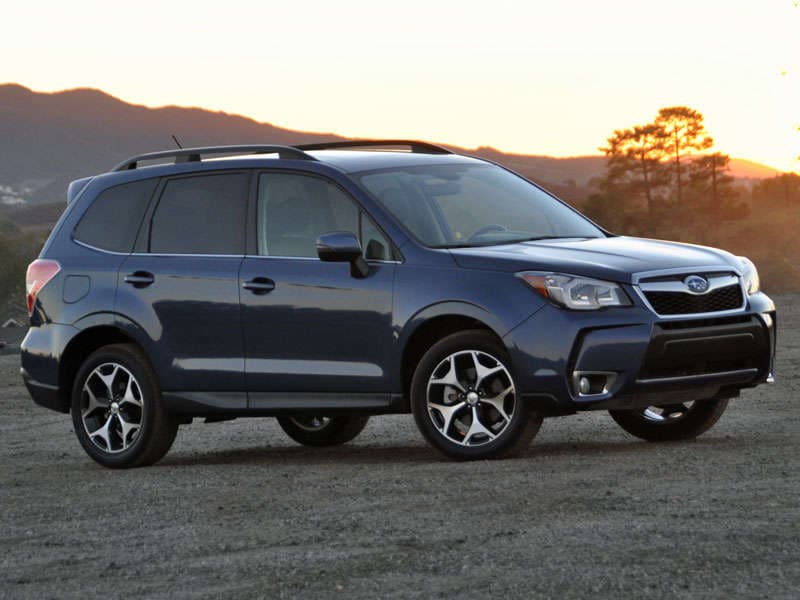
2014 Subaru Forester 2.0XT Review and Quick Spin: Comfort and Quality
Though the 2014 Subaru Forester is based on the same platform as the compact Impreza hatchback and sedan lineup, the crossover SUV is very roomy inside, and offers quite comfortable seating for four adults or, as the case may be, parents and three of their offspring.
Up front, the driver and passenger sit on supportive seats, the driver’s equipped with 8-way power adjustment. Headroom seems almost infinite, even in models with the giant sunroof, and thanks to a leather-wrapped tilt/telescopic steering wheel with a perfectly sized rim and handy thumb rests, plus a center console armrest that slides forward in order to adjust to people of varying heights, the Forester proves comfortable for longer drives but for three exceptions.
First, the upper portion of the front door panels is hard plastic. It should be soft, like the dashboard, because this is where some people (like me) will sometimes rest an arm or crook an elbow while driving. Second, the center console armrest pad is too thin. Density is an elbow’s friend when this component is leaned upon while fishing a phone, a wallet, cash, or other objects out of your pockets. Third, the spot where I braced my leg when taking corners in spirited fashion offered no padding for my knobby kneecaps, making it painful to toss the Forester 2.0XT into right-hand turns.
The Forester’s back seat is really roomy, and while the bottom cushion is a little too low for my preference, it sure is easy to climb into and out of the rear quarters. Offering plenty of leg room, lots of under-seat foot room, a nearly flat floor, a center armrest with built-in cupholders, and equipped with soft front seatbacks that are kind to the appendages with which they might come into contact, adults and kids alike have to trouble with this SUV’s spacious back seat.
Similarly, the Forester 2.0XT is equipped with a roomy, usefully shaped cargo area measuring 31.5 cu.-ft. ** behind the rear seat. That’s roughly equal to the trunks of two midsize family sedans. My 2.0XT Touring test vehicle included a protective rubber cargo floor mat and power folding rear seats. With the touch of a button, the split-folding rear seatbacks released and folded down to create 68.5 cu.-ft.** of cargo volume.
A power tailgate was also included with my test vehicle, but as handy as this feature can be, it also serves as an occasional irritant. Walking back to the Subaru, my 5-year-old fell, scraped her knees up on the cement, and was wailing. I wanted to set her in the cargo area to inspect the injuries, and as any parent seeking to assuage his child’s tears ASAP, I wasn’t really in the mood to wait for the Forester’s tailgate to power itself open. Impatiently, I used the touchpad release too many times in an effort to override the power and just yank it up, but the tailgate instead reversed course and latched itself. Arrrggh.
As I mentioned before, certain elements of the Forester’s interior do not exude quality, but they are exceptionally easy to clean. Tell you what, Subaru. Make the upper door panels soft like the dashboard, add denser padding to the sliding center console armrest, and I’ll call a truce. After all, with the soft-touch and low-gloss dash material, perforated leather with white contrast stitching, rubber liners for most of the storage spots, and Berber-style carpeted floor mats, the 2.0XT Touring model is most of the way to looking and feeling like the as-tested price is justified.
** Measurements apply to Forester models equipped with the panoramic sunroof.
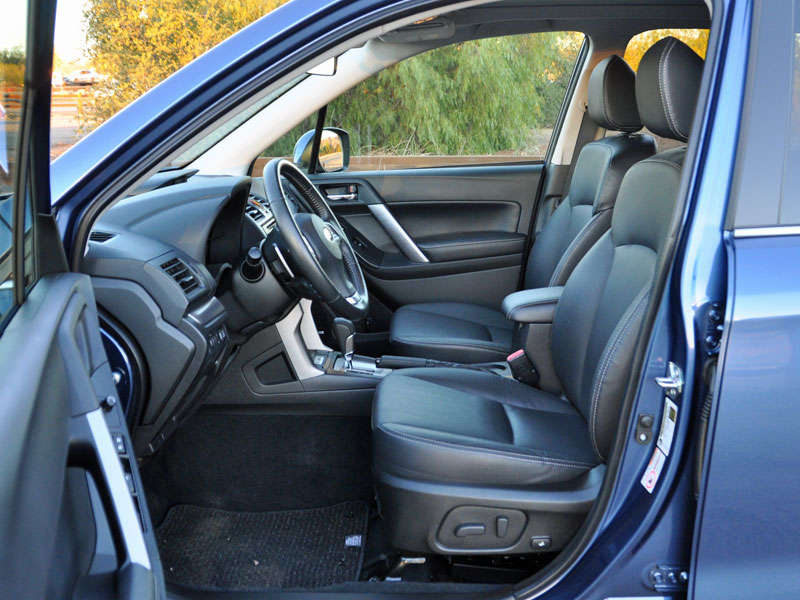
2014 Subaru Forester 2.0XT Review and Quick Spin: Features and Controls
As mentioned previously, Subaru’s Starlink infotainment system is not a treat to use, and this comment has nothing to do with how easy it is to pair a smartphone or in regard to its impressive array of features. Rather, it is the user interface that is flawed, starting with a small 6.1-inch touchscreen littered with buttons that require a fair degree of precision to use, and continuing with icons and lettering that is really hard to see. Subaru obviously outsources this solution, and that’s fine, but the end product comes across as half-baked. It needs to be better.
Graphics for the trip computer and vehicle system monitoring display are far better. In addition to fuel economy data, a clock, and an outside temperature gauge, this display allows the driver to monitor turbocharger engagement and pressure, the engine temperature to exact digits, and how the power is being distributed at any given time. There’s also a cool sunrise/sunset display showing a world map that is shaded where it is dark, just like on a trans-continental flight.
I paired my iPhone to Starlink with relative ease, and streamed my Pandora stations and iTunes library without much effort. Though the procedures are not entirely intuitive, this system isn’t hard to use, either. Unfortunately, the USB connection is located inside of the center console, which is good for hiding devices, but not so great for access on the fly.
The Forester’s enormous glass sunroof is not made of tinted glass. If you have the shade open on a summer day, you might as well be putting yourself and your passengers into a crock-pot. In my previous review of the Forester, I griped about this, and while this clear glass sure isn’t my preference, this time around I realized that it provides everyone with an unfettered view of their natural surroundings, and is perfect for star- or moon-gazing at night. In light of this, I suppose it’s not that hard to just leave the shade closed during the sunniest of days.
I’m still not going to forgive the Forester’s wonky altimeter readings. As is true of last Subaru I drove, I found the altitude reading to be inconsistent. At a beachside café, it said the SUV was parked at 62 feet above sea level, when it clearly was not. In my driveway, this Forester said I live at less than 800 feet of elevation. Previous Subarus have told me I live above that.
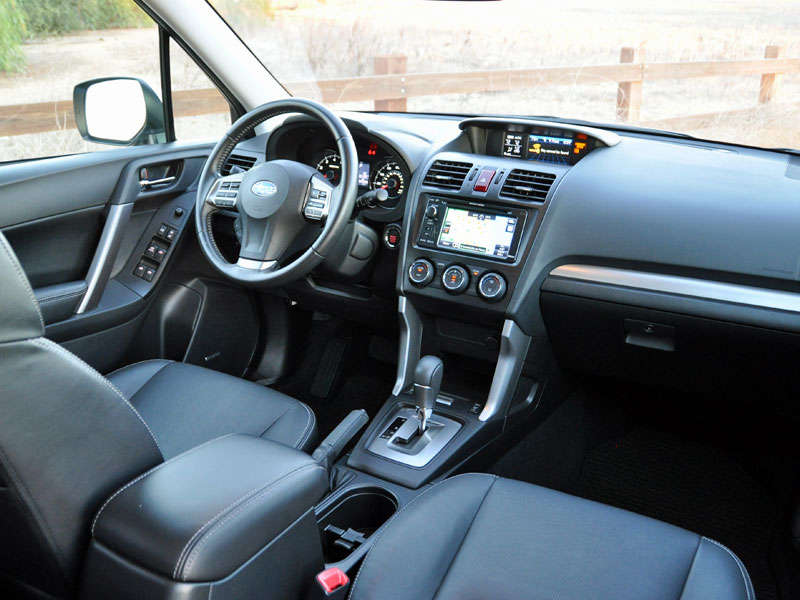
2014 Subaru Forester 2.0XT Review and Quick Spin: Matters of Safety
For the Subaru Forester’s optional EyeSight technology to be truly helpful and useful, opined my wife, it needs a Blind-spot Information System (BLIS). I don’t disagree. She and I both think that BLIS is one of the most important safety technologies to emerge in recent years, and we find it far more useful on the packed, multi-lane freeways of Los Angeles than most other new safety features.
What EyeSight does offer is technology highly valued by the Insurance Institute for Highway Safety (IIHS): a pre-collision system with pre-collision braking and throttle management. This system is designed to help avoid collisions or, at higher speeds, to help slow the Forester before impact in order to reduce injuries. As a result, the IIHS gives the Forester a “Superior” rating for front-crash prevention, and a “Top Safety Pick+” rating overall.
In addition to these crash-prevention features, EyeSight adds an adaptive cruise control system, a lane departure warning system, and a lane sway warning system. Be warned, though, that EyeSight is not infallible. While driving directly into dappled winter sunlight on a mountain road, EyeSight informed me that it could no longer see the road and that I was on my own.
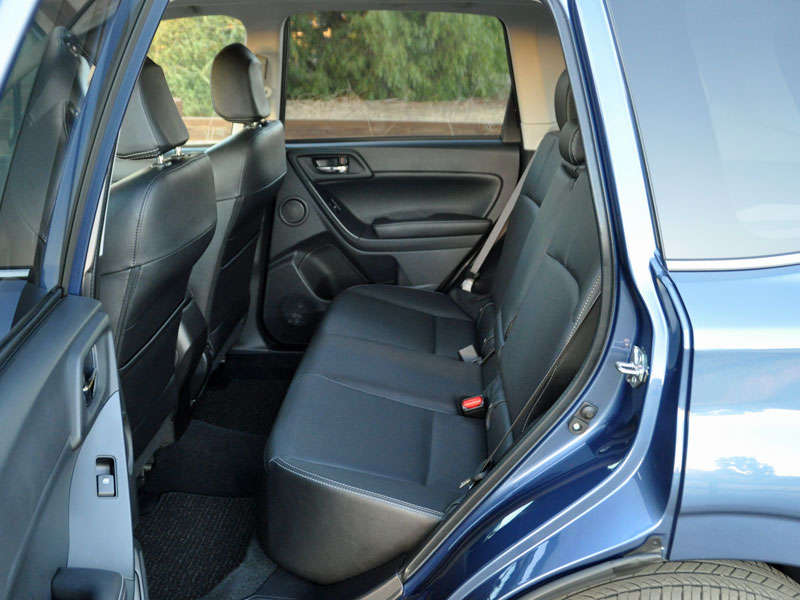
2014 Subaru Forester 2.0XT Review and Quick Spin: Driving Impressions
There’s a significant difference between the regular-strength Subaru Forester 2.5i and the extra-strength Forester 2.0XT. The turbocharged engine makes the XT come alive, zooming here, whooshing there, gobbling up twisty two-lane roads and kinked light-duty trails with equal vigor. That’s not surprising, considering that the direct-injected, turbocharged and intercooled 2.0-liter 4-cylinder engine is whipping up 250 horsepower at 5,600 rpm and 258 lb.-ft. of torque between 2,000 rpm and 4,800 rpm, 80 extra horsepower and 84 more lb.-ft. of torque than a Forester 2.5i.
The performance-calibrated continuously variable transmission (CVT) does a remarkably good job of responding to driver inputs, but when using the paddle shifters, the upshifts are soft, barely perceptible, and not at all rewarding to an enthusiast driver. In fact, the powertrain is generally lacking in characteristic Subaru grumble. I heard more turbocharger whistling and whine than I did typical boxer-engine noise, vibration and harshness, and I reference the NVH with affection, not disdain.
Subaru Intelligent Drive (SI-Drive) is standard for the Forester 2.0XT, offering three different driving modes. For normal driving conditions, choose Intelligent mode for power when you want it combined with the best possible fuel economy. Sport mode enlivens the Forester 2.0XT’s powertrain, making the SUV feel more athletic and energetic. Sport Sharp (the musicians among you will appreciate the “S#” marking on the button) does what it sounds like it will by sharpening drivetrain response to deliver maximum performance.
There’s a palpable difference between SI-Drive’s different modes, and I regularly switched between Intelligent mode and Sport Sharp mode during my week with the Forester, depending on driving conditions. Still, considering that my family put lots of highway miles on the Forester, twice traveling an hour from home entirely on freeways, my 23.4-mpg average isn’t terribly encouraging. The EPA says this model should get 23 mpg in the city, not in combined driving with a heavy emphasis on highway cruising.
Aside from disappointing fuel economy, the Forester 2.0XT handling wasn’t as adept as expected. Perhaps I was expecting a bigger, roomier Subaru WRX, which is silly because this is a vehicle designed to travel on both paved roads and dirt trails, and is equipped with tires and suspension tuning reflecting as much. As a result, the Forester 2.0XT’s uspension allows too much roll in corners, and the tires are too squishy for really enthusiastic driving.
Get the Forester into the dirt, though, and it goes places lots of other vehicles can’t. It’s not a serious off-roader, but it provides a generous 8.7 inches of ground clearance combined with enough wheel articulation to continue the journey when lots of other crossovers are forced to stop and turn around.
Descending from the mountains to the ocean, the Forester 2.0XT’s larger, 4-wheel ventilated-disc brakes proved fade-free despite repeated and hard use. The pedal is perfectly calibrated and allows for easy modulation, but I found it hard to bring the Forester to a stop without a slight shudder just as the SUV came to a halt. Additionally, the Forester’s steering is nicely calibrated in terms of off-center resistance and feel, but I sure would have liked for it to be quicker.
Outward visibility is excellent, and the Forester provides a tight turning radius that helps to make it easy to park. You’ll want to note, though, that if you open the sunroof all of the way and drive with the side windows sealed, lots of reverberation fills the cabin. I also thought the reversing camera’s image was too small and of relatively low resolution, limiting effectiveness to some degree.
Overall, I liked the Forester 2.0XT plenty, and I live relatively near sea level. My bet is that residents of high-altitude locales, like my former home of Denver, will utterly adore this SUV, which for is basically a Rocky Mountain sports car.
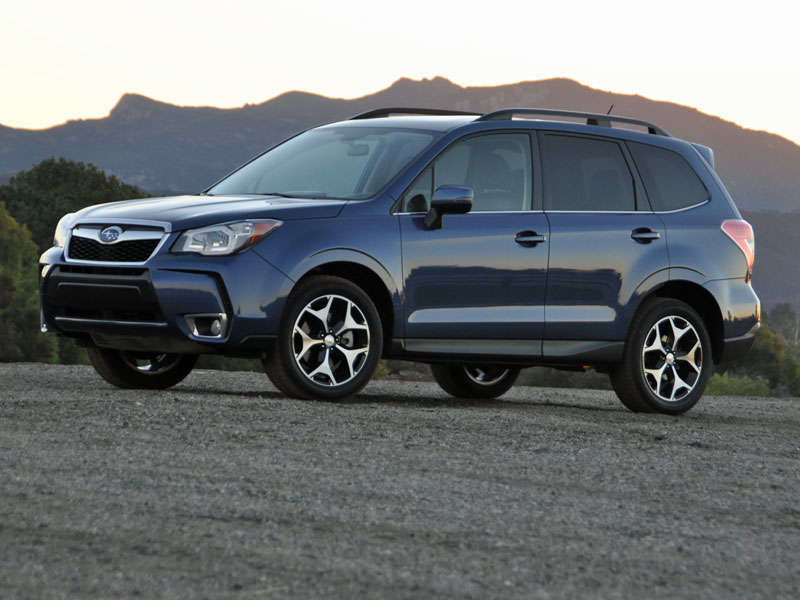
2014 Subaru Forester 2.0XT Review and Quick Spin: Final Thoughts
No surprise here. Add significant amounts of horsepower and torque to any engine, and the end result is a completely different vehicle. That’s certainly true of the 2014 Subaru Forester 2.0XT, and while it remains a flawed crossover in several respects, it’s also one of the most compelling choices in the small SUV class. The good news for Subaru is that it won’t need to work overtime in order to perfect the Forester.
Subaru provided the 2014 Forester 2.0XT for this review
2014 Subaru Forester 2.0XT photos by Christian Wardlaw
